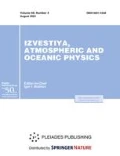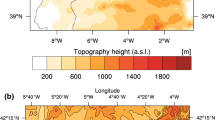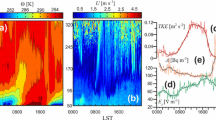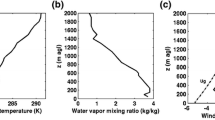Abstract
The planetary boundary layer (PBL), which directly interacts with the underlying surface, differs significantly in its nature from the low-turbulent stably stratified free atmosphere. Fluctuations of the Earth’s surface heat balance immediately affect the PBL and assimilate there owing to the effective mechanism of turbulent heat transfer. In this case the upper boundary of the PBL plays the role of a cover, preventing the direct penetration of thermal effects and contaminants into an overlying atmospheric layer. In view of this, air pollution is especially dangerous when associated with shallow PBL. In addition, local peculiarities of climate change are mainly determined by the PBL height due to the high sensitivity of thin stably stratified PBLs to the thermal effects. Deep convective PBLs are not very sensitive to weak thermal effects, but they significantly affect the formation of convective cloudiness and the climate system as a whole by means of the turbulent entrainment of the thermal energy, humidity, aerosols, and other admixtures through the upper boundary. The PBL height and turbulent entrainment must be calculated when simulating and forecasting air pollution, abnormal frosts and heat, and other hazardous phenomena. In this paper we discuss the state-of-the-art knowledge in the area of PBL height simulation and suggest a new model of turbulent entrainment for convective PBLs.
Similar content being viewed by others
References
S. S. Zilitinkevich and I. N. Esau, “Planetary Boundary Layer Feedbacks in Climate System and Triggering Global Warming in the Night, in Winter and at High Latitudes,” Geogr. Environ. Sustainabil. 1(2), 20–34 (2009).
I. Esau and S. Zilitinkevich, “On the Role of the Planetary Boundary Layer Depth in the Climate System,” Adv. Sci. Res. 4, 63–69 (2010).
N. N. Zubov, Arctic Ice (Izd. Glavsevmorputi, Moscow, 1945) [in Russian].
A. Baklanov, “Parameterisation of SBL Height in Atmospheric Pollution Models,” in Air Pollution Modeling and Its Application XV, Ed. by C. Borrego and G. Schayes (Kluwer Academic/Plenum Publishers, New York, 2002), pp. 415–424.
S. Zilitinkevich, A. Baklanov, J. Rost, et al., “Diagnostic and Prognostic Equations for the Depth of the Stably Stratified Ekman Boundary Layer,” Q. J. R. Meteorol. Soc. 128(579), 25–46 (2002).
S. Zilitinkevich and A. Baklanov, “Calculation of the Height of the Stable Boundary Layer in Practical Applications,” Boundary-Layer Meteorol., 1993, vol. 63, pp. 65–96. 105 (3), 389–409 (2002).
S. S. Zilitinkevich and I. N. Esau, “On Integral Measures of the Neutral Barotropic Planetary Boundary Layer,” Boundary-Layer Meteorol., 1993, vol. 63, pp. 65–96. 104 (3), 371–379 (2002).
S. S. Zilitinkevich and I. N. Esau, “The Effect of Baroclinicity on the Equilibrium Depth of Neutral and Stable Planetary Boundary Layers,” Q. J. R. Meteorol. Soc. 129(595), 3339–3356 (2003).
S. Zilitinkevich, I. Esau, and A. Baklanov, “Further Comments on the Equilibrium Height of Neutral and Stable Planetary Boundary Layers,” Q. J. R. Meteorol. Soc. 133(622), 265–271 (2007).
S. Zilitinkevich and P. Calanca, “An Extended Similarity Theory for the Stably Stratified Atmospheric Surface Layer,” Q. J. R. Meteorol. Soc. 126(566), 1913–1923 (2000).
S. S. Zilitinkevich, “Third-Order Transport due to Internal Waves and Non-Local Turbulence in the Stably Stratified Surface Layer,” Q. J. R. Meteorol. Soc. 128(581), 913–925 (2002).
I. N. Esau, “Parameterization of a Surface Drag Coefficient in Conventionally Neutral Planetary Boundary Layer,” Ann. Geophys. 22, 3353–3362 (2004).
S. S. Zilitinkevich and I. N. Esau, “Resistance and Heat-Transfer Laws for Stable and Neutral Planetary Boundary Layers: Old Theory Advanced and Re-Evaluated,” Q. J. R. Meteorol. Soc. 131(609), 1863–1892 (2005).
V. W. Ekman, “On the Influence of the Earth’s Rotation on Ocean Currents,” Arkiv für matematik, astronomi och fysik 2(11), 1–52 (1905).
C. G. Rossby and R. B. Montgomery, “The Layer of Frictional Influence in Wind and Ocean Currents,” Pap. Phys. Oceanogr. Meteorol. 3(3), 1–101 (1935).
S. S. Zilitinkevich, “On the Determination of the Height of the Ekman Boundary Layer,” Boundary-Layer Meteorol., 1993, vol. 63, pp. 65–96. 3 (2), 141–145 (1972).
S. J. Caughey, J. C. Wyngaard, and J. C. Kaimal, “Turbulence in the Evolving Stable Boundary Layer,” J. Atmos. Sci. 36(6), 1041–1052 (1979).
Atmospheric Turbulence and Air Pollution Modelling, Ed. by F. T. M. Nieuwstadt and H. Van Dop (D. Reidel, Dordrecht, 1982).
J. R. Holton, An Introduction to Dynamic Meteorology (Academic Press, New York, 1972).
J. W. Deardorff, “Parameterization of the Planetary Boundary Layer for Use in General Circulation Models,” Mon. Wea. Rev. 100(2), 93–106 (1972).
A. K. Betts, “Non-Precipitating Cumulus Convection and Its Parameterization,” Q. J. R. Meteorol. Soc. 99(419), 178–196 (1973).
D. J. Carson, “The Development of a Dry Inversion-Capped Convectively Unstable Boundary Layer,” Q. J. R. Meteorol. Soc. 99(421), 450–467 (1973).
H. Tennekes, “A Model for the Dynamics of the Inversion above a Convective Boundary Layer,” J. Atmos. Sci. 30(4), 558–567 (1973).
R. B. Stull, “Mixed-Layer Depth Model Based on Turbulent Energetics,” J. Atmos. Sci. 33(7), 1268–1278 (1976).
S.-E. Gryning and E. Batchvarova, “Analytical Model for the Growth of the Coastal Internal Boundary Layer during Onshore Flow,” Q. J. R. Meteorol. Soc. 116(491), 187–203 (1990).
E. Batchvarova and S. -E. Gryning, “Applied Model for the Growth of the Daytime Mixed Layer,” Boundary-Layer Meteorol., 1993, vol. 63, pp. 65–96. 56 (3), 261–274 (1991).
P. Seibert, F. Beyrich, S.-E. Gryning, et al., “Review and Intercomparison of Operational Methods for the Determination of the Mixing Height,” Atmos. Environ. 34(7), 1001–1027 (2000).
S. S. Zilitinkevich, Turbulent Penetrative Convection (Avebury Technical., Aldershot, 1991).
S. S. Zilitinkevich, “Comments on’ A Model for the Dynamics of the Inversion above a Convective Boundary Layer’,” J. Atmos. Sci. 32(5), 991–992 (1975).
S. S. Zilitinkevich, “A Theoretical Model of Penetrating Turbulent Convection,” Izv. Akad. Nauk SSSR, Fiz. Atmos. Okeana 23(6), 593–610 (1987).
Yu. I. Troitskaya, D. A. Sergeev, E. V. Ezhova, et al., “Self-Induced Internal Waves Excited by Buoyant Plumes in a Stratified Tank,” Dokl. Earth Sci. 419(5), 506–510 (2008).
V. G. Bondur, Yu. V. Grebenyuk, E. V. Ezhova, et al., “Surface Manifestations of Internal Waves Investigated by a Subsurface Buoyant Jet: 1. The Mechanism of Internal-Wave Generation,” Izv. Atmos. Ocean. Phys. 45(6), 779–790 (2009).
V. G. Bondur, Yu. V. Grebenyuk, E. V. Ezhova, et al., “Surface Manifestations of Internal Waves Investigated by a Subsurface Buoyant Jet: Part 2. Internal Wave Field,” Izv. Atmos. Ocean. Phys. 46(3), 347–359 (2010).
V. G. Bondur, Yu. V. Grebenyuk, E. V. Ezhova, et al., “Surface Manifestations of Internal Waves Investigated by a Subsurface Buoyant Jet: 3. Surface Manifestations of Internal Waves,” Izv. Atmos. Ocean. Phys. 46(4), 482–491 (2010).
O. A. Druzhinin and Yu. I. Troitskaya, “Auto-Generation of Internal Waves by a Fountain in a Stratified Fluid,” Izv. Akad. Nauk, Mekh. Zhidk. Gaza, no. 3, 147–158 (2010).
S. N. Reznik and Yu. I. Troitskaya, “The Wave Resistance of a Localized Bottom Heterogeneity in a Stratified Shear Flow with a Critical Layer,” Izv. Atmos. Ocean. Phys. 32(1), 122–129 (1996).
Yu. I. Troitskaya, “The Viscous-Diffusion Nonlinear Critical Layer in a Stratified Shear Flow,” J. Fluid Mech. 233, 25–48 (1991).
C. G. Knight, S. H. E. Knight, N. Massey, et al., “Association of Parameter, Software, and Hardware Variation with Large-Scale Behavior across 57.000 Climate Models,” Proc. Natl. Acad. Sci. USA 104(30), 12259–12264 (2007).
W. A. Hoppel, R. V. Anderson, and J. C. Willett, “Atmospheric Electricity in the Planetary Boundary Layer,” in The Earth’s Electrical Environment, Ed. by E. P. Krider and R.G. Roble (National Academy Press, Washington, DC, 1986), pp. 149–165.
S. V. Anisimov, E. A. Mareev, and S. S. Bakastov, “On the Generation and Evolution of Aeroelectric Structures in the Surface Atmospheric Layer,” J. Geophys. Res. 104(D12), 14359–14368 (1999).
S. V. Anisimov and E. A. Mareev, “Spectra of Electric Field Pulsations in the Near-Surface Atmosphere,” Dokl. Akad. Nauk 381(8), 975–980 (2001).
S. V. Anisimov, E. A. Mareev, N. M. Shikhova, et al., “Universal Spectra of Electric Field Pulsations in the Atmosphere,” Geophys. Rev. Lett. 29(24), 74–79 (2002).
E. A. Mareev and O. V. Mareeva, “Nonlinear Electric-Field and Charge Structures in the Atmosphere,” Geomagn. Aeron. 39(6), 743–748 (1999).
E. A. Mareev, “Formation of Charge Layers in the Planetary Atmospheres,” Space Science Reviews 137(1–4) (2008). doi: 10.1007/s11214-008-9306-2
S. V. Anisimov and E. A. Mareev, “Geophysical Studies of the Global Electric Circuit,” Izv. Phys. Solid Earth 44(10), 760–769 (2008).
E. A. Mareev, “Advances and Prospects of Studies of the GLocal Electrical Circuit,” Usp. Fiz. Nauk 180(5), 527–534 (2010).
Author information
Authors and Affiliations
Corresponding author
Additional information
Original Russian Text © S.S. Zilitinkevich, S.A. Tyuryakov, Yu.I. Troitskaya, E.A. Mareev, 2012, published in Izvestiya AN. Fizika Atmosfery i Okeana, 2012, Vol. 48, No. 1, pp. 150–160.
Rights and permissions
About this article
Cite this article
Zilitinkevich, S.S., Tyuryakov, S.A., Troitskaya, Y.I. et al. Theoretical models of the height of the atmospheric boundary layer and turbulent entrainment at its upper boundary. Izv. Atmos. Ocean. Phys. 48, 133–142 (2012). https://doi.org/10.1134/S0001433812010148
Received:
Accepted:
Published:
Issue Date:
DOI: https://doi.org/10.1134/S0001433812010148




